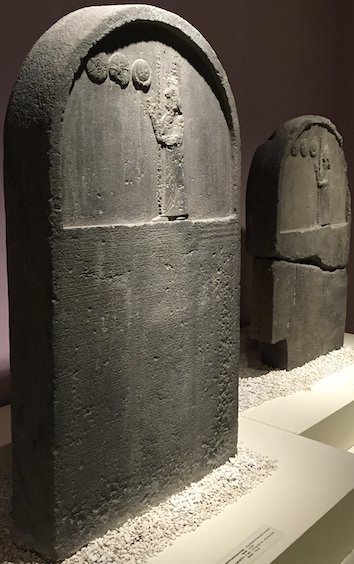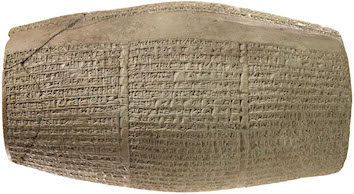Nabonidus (r. 555–539 BC)

Two inscribed Neo-Babylonian steles written in the name of Nabonidus' mother Adad-guppi. Image credit: Ronnie Jones III, "Tablets with King Nabonidus Inscriptions, Harran," World History Encyclopedia. © Ronnie Jones III.
Like his predecessors, Nabonidus, Babylon's last native king, actively sponsored construction throughout Babylonia. Some of the work was supervised by his son Belshazzar (Akkadian Bēl-šarru-uṣur), who acted as the de facto ruler of Babylon during his father's ten-year sojourn in Arabia. From extant textual sources, mostly royal inscriptions, these building projects are:
- Agade
- Eulmaš (temple of the goddess Ištar)
- Babylon
- Dukisikil (seat of the deities Enmešara and Enbilulu)
- Ehalanki (seat of the goddess Zarpanitu in Edara'ana)
- Emah (temple of the goddess Bēlet-ilī)
- Emašdari (temple of the goddess Ištar of Agade)
- Esagil (temple of the god Marduk)
- Gate of Bēltīya: (northern gate of the main temple of Esagil; = Ka-Lamma-arabi)
- Kagula
- Imgur-Enlil and Nēmetti-Enlil (the inner city walls)
- South Palace
- Borsippa
- cella of the goddess Tašmētu (ceremonial name not known)
- Elagabgid (possibly a temple magazine)
- Eurmeiminanki (ziggurat of the god Nabû)
- Ezida (temple of the god Nabû)
- Cutha
- Ugal-amaru and Nergal-lugal-me-du (city walls)
- Dilbat
- New Year's temple of the god Uraš
- Kish
- Melem-kurukurra-dulla (city wall)
- Kissik
- Eamaškuga (temple of the goddess Ningal)
- Larsa
- Ebabbar (temple of the god Šamaš)
- Edurana (ziggurat of the god Šamaš)
- Marad
- Eigikalama (temple of the god Lugal-Marda)
- Sippar
- Ebabbar (temple of the god Šamaš)
- Ekunankuga (ziggurat of the god Šamaš)
- Ekura (temple of the god Bunene)
- Sippar-Anunītu
- Eulmaš (temple of the goddess Anunnītu)
- Ubassu
- unnamed sanctuary of the goddess Nanāya
- Ur
- Egipar (residence of the ēntu-priestess of the god Sîn)
- Elugalgalgasisa (ziggurat of the god Sîn)
- Enunmah (bīt hilṣi of the goddess Ningal)
- Uruk
- Eanna (temple of the goddess Ištar)

VA 02536, a three-column clay cylinder that is inscribed with the so-called "Ehulhul Cylinder Inscription" of Nabonidus. Ehulhul's reconstruction is recorded in detail in cols. i–ii. © Staatliche Museen zu Berlin – Vorderasiatisches Museum. Photo: Olaf M. Teßmer.
At Babylon, Nabonidus might have also sponsored construction on a royal residence located near the Šamaš Gate, in the southern wall of West Babylon, assuming that the text in question actually records work in Babylon, and not in some other city (for example, Borsippa, Dilbat, Sippar, and Uruk). Bricks discovered at Seleucia could attest to Nabonidus having undertaken work in or near that city, perhaps at Opis (ancient Upî; Tulūl al-Mujailiʿ), which is only a short distance away from Seleucia on Tigris.
In addition to undertaking construction, Nabonidus claims to have made generous donations to Babylonian temples and their divine residents. The most notable of these are the creation of a new throne for the god Ea in his temple Ekarzagina (located in the Esagil complex at Babylon) and the donation of an exceptional large gift to Esiskur (New Year's temple outside and north of the inner city of Babylon).
Like Ashurbanipal (r. 668–ca. 631 BC), the last great king of Assyria, Nabonidus rebuilt all of the temples of the Ehulhul temple complex of the god Sîn at Harran — a large garrison and important trading center situated on the route between the Mediterranean Sea and the plains of the middle Tigris — and returned that city's patron deities to their rightful places. In memory of his mother Adad-guppi (Aramaic Hadad-ḥappī), a woman who lived to the old age of 101 (although her stele inscription states that she was 104), Nabonidus had steles erected in Ehulhul in order to honor her life-long devotion to the moon-god, the patron deity of Harran, her (assumed) birth city.
Furthermore, Nabonidus, during his extended sojourn in Arabia, appears to have undertaken construction on a royal residence at Tēmā, as well as on other important structures in that oasis city.
General Remarks on Nabonidus' Building Activities
Unlike his immediate predecessors, Nabonidus regularly stated that he instructed his workmen to carefully and painstakingly search for the original foundations of buildings in order to ensure that the buildings were constructed anew precisely on their original, divinely-sanctioned sites, thereby ensuring that structures endured for a long time and did not prematurely collapse; learned and experienced men from Babylon and Borsippa regularly assisted the king in these matters. To avoid missteps in building and to guarantee success, Nabonidus regularly consulted the gods, especially the sun-god Šamaš and the storm-god Adad, the lords of divination, through extispicy: his texts sometimes record the (positive as well as negative) outcomes of those haruspicial queries.
As a result of Nabonidus' extreme precautions, or so we are meant to believe, this king's workmen are often recorded as discovering (ancient) inscribed objects (for example, statues or foundation documents) that had been deposited within the (original) structure of the building by a(n important) former king. References to selected, famous rulers of the past not only highlighted the special relationship that the divine occupant of the temple under construction/renovation had had with important men from the (distant) past, but also gave Nabonidus' deeds legitimacy. Thanks to Nabonidus' royal inscriptions, we possess some pre-Neo-Babylonian information about some temples' previous builders, details in many instances that are not preserved in contemporary sources.
Jamie Novotny & Niclas Dannehl
Jamie Novotny & Niclas Dannehl, 'Nabonidus (r. 555–539 BC)', Babylonian Temples and Monumental Architecture online (BTMAo), The BTMAo Project, a sub-project of MOCCI, [http://oracc.org/btmao/StructuresbyBuilder/Neo-BabylonianEmpire/Nabonidus/]